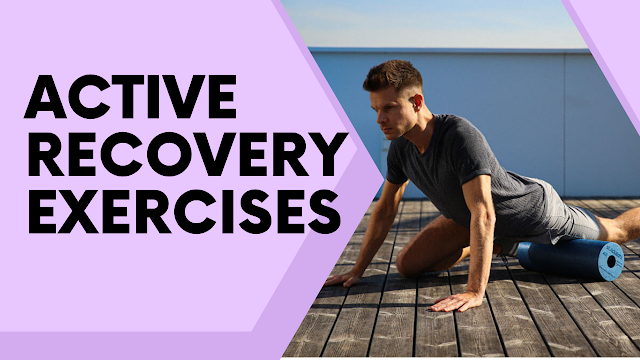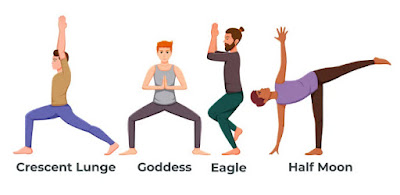Active recovery exercises are an essential component of any well-rounded fitness routine. Unlike traditional rest days where you may completely refrain from physical activity, active recovery focuses on engaging in low-intensity exercises that promote healing and restoration of the body. By incorporating active recovery into your routine, you can optimize your recovery, reduce muscle soreness, improve flexibility, and prevent overtraining.
Understanding the importance of active recovery will empower you to optimize your performance and achieve your fitness goals while minimizing the risk of injury and burnout.
In this guide we’ll cover the following:
- What exactly is Active Recovery Exercises?
- Why is Active Recovery Exercises Important?
- Benefits of Active Recovery Exercises
- Types of Active Recovery Exercises
- How to Design an Effective Active Recovery Program
- Common Mistakes to Avoid in Active Recovery
- Tips for Implementing Active Recovery into Your Fitness Regimen
- Active Recovery Exercises for Different Fitness Levels
You won't believe how much information this article provides!
Well let's start.
What is Active Recovery Exercises?
Active recovery is like a spa day for your muscles. It involves engaging in low-intensity exercises or activities after a tough workout or intense physical activity. These exercises are designed to promote blood flow, reduce muscle tension, and help your body recover faster.
Why is Active Recovery Important?
Active recovery is the secret weapon in every athlete's arsenal. It not only helps prevent those dreaded muscle aches and pains, but it also enhances muscle recovery, improves flexibility, and prevents overtraining. By incorporating active recovery exercises into your routine, you can keep your body in tip-top shape and ready for your next killer workout.
Benefits of Incorporating Active Recovery exercises into Your Routine
1. Enhanced Muscle Recovery
If you want to bounce back quicker from your intense workouts, active recovery is the way to go. By engaging in low-intensity movements, you increase blood flow to your muscles, which helps deliver essential nutrients and oxygen to aid in their repair and recovery. Say goodbye to those days of hobbling around like a wounded penguin after leg day!
2. Reduced Muscle Soreness
We've all experienced that delightful feeling of post-workout muscle soreness. But fear not! Active recovery exercises can help alleviate that discomfort. By gently moving your body, you stimulate the release of endorphins, which act like natural painkillers. So, instead of feeling like a human pretzel, you'll be back to strutting your stuff in no time.
3. Improved Flexibility and Range of Motion
Active recovery isn't just about recovery; it's also about improving your overall fitness. By incorporating stretching and flexibility exercises into your routine, you can increase your range of motion and keep your joints happy and healthy. So, get ready to touch your toes without feeling like a rusty door hinge!
4. Prevention of Overtraining
Overtraining is like trying to run a marathon with a broken shoelace – it's a recipe for disaster. But active recovery is here to save the day! By giving your body the rest and recovery it needs, you can prevent overtraining and avoid hitting that dreaded plateau. So, let active recovery be your superhero sidekick in the fight against burnout.
Types of Active Recovery Exercises
1. Low-Impact Cardiovascular Exercises
Think of low-impact cardio exercises like a gentle dance party for your heart. Walking, swimming, or cycling at a leisurely pace can get your blood flowing without putting excess stress on your joints. So lace up your sneakers or put on your swim cap and get ready to groove your way to recovery.
2. Foam Rolling and Self-Myofascial Release
Foam rolling may look like a medieval torture device, but trust us, your muscles will thank you for it. Using a foam roller or other self-massage tools, you can target tight spots and knots in your muscles, releasing tension and increasing blood flow. Just be prepared for some uncomfortable-yet-satisfying groans as you roll away those muscle knots.
3. Yoga and Stretching
Stretching and yoga are the cool down to your workout's rock concert. These exercises help improve flexibility, promote relaxation, and reduce muscle stiffness. Plus, the zen-like state you'll achieve after a yoga session might just have you levitating off the mat (or at least feeling like it).
4. Light Resistance Training
Who said lifting weights was only for heavy lifting? Incorporating light resistance training into your active recovery routine can help maintain muscle strength and prevent muscle imbalances. So grab those light dumbbells or resistance bands and give your muscles a little love tap.
Best 5 Active recovery Exercises ever
1.Walking
It does not require any prior knowledge of gym equipment or require a gym membership, making it a straightforward and often cost-free alternative to some other activities.
2.Swimming
Swimming is a low impact exercise that is a good method of active recovery.
3.Cycling
Going for a gentle bike ride is another option for active recovery. People can use a stationary bike or go cycling outside.
4.Yoga
Even gentle yoga can have positive effectsTrusted Source on the body, helping regulate blood glucose levels, reduce musculoskeletal aches and pains, and improve posture.
5.Self-myofascial release with a foam roller
Another form of active recovery is self-massage, or self-myofascial release, which someone can perform with a foam roller.
How to Design an Effective Active Recovery Program
1. Assessing Your Recovery Needs
Before diving into active recovery, take a moment to assess your body's needs. Consider factors like the intensity and duration of your workouts, any previous injuries, and your overall fitness goals. This will help you tailor your active recovery program to suit your specific needs.
2. Determining Frequency and Duration
The frequency and duration of your active recovery sessions will depend on your individual circumstances. Generally, incorporating active recovery exercises into your routine for 10 to 30 minutes, a few times a week, can yield significant benefits. However, listen to your body and adjust accordingly.
3. Choosing Appropriate Exercises
The key to designing an effective active recovery program is choosing exercises that target the muscles you've worked during your intense workouts. You want to engage in low-intensity exercises that promote blood flow and mobility without fatiguing your muscles further. So, pick exercises that are gentle and enjoyable for you.
4. Progression and Modification
As your body adapts and becomes more accustomed to active recovery exercises, you can gradually increase the intensity or duration. However, be sure to make changes slowly and progressively to avoid overdoing it. Remember, active recovery is supposed to leave you feeling refreshed, not exhausted.
Now that you're armed with the knowledge of active recovery exercises, go forth and give your muscles the love and care they deserve. Your body will thank you, and you'll be ready to conquer your next workout with zest and enthusiasm. Happy recovering!
Common Mistakes to Avoid in Active Recovery
1. Overexertion and Intensity
When it comes to active recovery, one common mistake is going too hard or intense with your workouts. Remember, the goal here is to promote recovery, not push your limits. Overexerting yourself can lead to further muscle damage and delay the healing process. So, take it easy and dial down the intensity. It's all about finding that sweet spot between movement and rest.
2.Neglecting Proper Form and Technique
Even during active recovery, it's crucial to maintain proper form and technique. Poor form can put unnecessary stress on your muscles and joints, increasing the risk of injury. So, whether you're doing light stretches or gentle movements, pay attention to your body alignment, posture, and breathing. Focus on quality over quantity, and don't compromise your form just because it's a recovery session.
3. Ignoring Individual Recovery Needs
Active recovery is not a one-size-fits-all approach. We all have unique recovery needs based on our fitness level, body, and specific activities. Ignoring these individual needs can hinder your progress and potentially lead to setbacks. It's important to listen to your body and adjust your active recovery accordingly. If you feel excessively fatigued or sore, don't hesitate to take it easy or incorporate more rest days. Tailor your recovery to what works best for you.
Tips for Implementing Active Recovery Exercises into Your Fitness Regimen
1. Scheduling Active Recovery Sessions
To make active recovery a consistent part of your fitness regimen, it's essential to schedule dedicated sessions for it. Just like you plan your intense workouts, set aside specific times for active recovery. Whether it's a gentle yoga class, a leisurely walk, or a swim, make sure it has a designated spot in your calendar. By treating it as a priority, you'll be more likely to follow through and reap the benefits of active recovery.
2. Listening to Your Body
One of the key principles of active recovery is listening to your body. Pay attention to how you feel physically and mentally. If you're experiencing excessive fatigue, muscle soreness, or any discomfort, it might be a sign that you need more recovery time. On the other hand, if you're feeling energized and ready to move, you can incorporate slightly more challenging exercises. Trust your instincts and adjust your active recovery accordingly.
3. Incorporating Variety into Your Active Recovery Routine
Active recovery doesn't have to be boring or repetitive. In fact, incorporating variety into your routine can enhance its effectiveness and keep you engaged. Explore different activities that promote gentle movement and relaxation. From foam rolling and mobility exercises to low-impact cardio and light resistance training, there are numerous options to choose from. Mixing it up not only prevents monotony but also targets different muscle groups, aiding overall recovery.
Active Recovery Exercises for Different Fitness Levels
1. Active Recovery Exercisers for Beginners
If you're new to active recovery, start with simple exercises like walking, gentle stretching, and basic bodyweight movements. Focus on promoting blood flow and mobilizing your joints. Gradually increase the duration and intensity as your body adapts.
2. Active Recovery Exercisers for Intermediate
Intermediate exercisers can incorporate a wider range of activities into their active recovery routine. Explore options like swimming, cycling, light resistance training, or attending low-impact group classes. The goal remains the same: promoting recovery without pushing your limits.
3. Active Recovery Exercisers for Advanced Athletes
For advanced athletes, active recovery may involve more specific techniques, such as foam rolling, mobility drills, or yoga sessions. These activities target tight muscles, improve flexibility, and aid in overall recovery. Additionally, active recovery can include low-intensity cross-training exercises that work different muscle groups or focus on active recovery workouts designed by professionals.
In Conclusion
Incorporating active recovery exercises into your fitness routine is key to achieving optimal performance and maintaining long-term progress. By allowing your body to recover and heal through low-intensity exercises, you can enhance muscle recovery, reduce soreness, improve flexibility, and prevent overtraining.
Remember to listen to your body, design a program that suits your individual needs, and prioritize active recovery as an integral part of your overall fitness regimen. By making active recovery a consistent practice, you can improve your overall fitness, maximize your performance, and ensure long-term success in your fitness journey.
Frequently Asked Question (FAQ)
1. How often should I incorporate active recovery exercises into my routine?
The frequency of active recovery exercises will depend on various factors such as your fitness level, intensity of your regular workouts, and individual recovery needs. As a general guideline, aim for at least 1-3 active recovery sessions per week. However, listen to your body and adjust the frequency as needed. If you're experiencing excessive muscle soreness or fatigue, consider adding more active recovery days to allow for proper recovery.
2. Can I do any type of exercise for active recovery?
While there is flexibility in choosing active recovery exercises, it's important to prioritize low-intensity activities that promote blood flow, flexibility, and muscle recovery. Opt for exercises such as light cardio (walking, swimming), stretching, yoga, foam rolling, or light resistance training. Avoid high-impact or intense activities that may hinder recovery or add additional stress to your body.
3. Is active recovery only for athletes or can anyone benefit from it?
Active recovery is beneficial for individuals of all fitness levels, not just athletes. Whether you are a beginner or an advanced exerciser, incorporating active recovery exercises can help improve your overall performance, reduce muscle soreness, and prevent overtraining. It is a valuable practice for anyone looking to optimize their fitness routine and promote long-term progress and well-being.
4. Can active recovery replace rest days?
Active recovery is not meant to replace rest days entirely. Rest days are still essential for allowing your body to fully recover and repair. Active recovery serves as a supplement to rest days by engaging in low-intensity exercises that promote recovery without putting excessive strain on your muscles and joints. Striking a balance between rest days and active recovery can help optimize your recovery process and overall performance.
These are Best Active Recovery Exercises for Your Rest Days.
What do you think of this guide?
Let me know by leaving a comment below, and don't forget to share this guide if you found it helpful.





